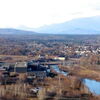
Processing Your Payment
Please do not leave this page until complete. This can take a few moments.
Housing developers are trying to bulldoze their way through the crisis
 Photo / Tim Greenway
Tom Landry, broker and owner of Benchmark Real Estate, at the lot where they are building Solaris, an eco-lux condo building on Munjoy Hill.
Photo / Tim Greenway
Tom Landry, broker and owner of Benchmark Real Estate, at the lot where they are building Solaris, an eco-lux condo building on Munjoy Hill.
Those who make their living in real estate and development are, by nature, optimists. They put a lot of time, effort and money into the present — dealing with tight margins, delays, ordinances and other issues — with the expectation that it will pay off in the end.
The coronavirus crisis hasn’t changed that. Real estate and development is considered an essential service under the state’s public health and safety business restrictions, and Mainebiz caught up with three residential developers whose projects were interrupted by the crisis to find out what impact it’s had so far and how they see the other side.
Staying in control
Things were “overheated” anyway, Tom Landry says. Now there’s an opportunity to slow things down, catch a breath.
Landry, owner of Benchmark Real Estate, last fall announced the nine-unit “eco-lux” Solaris development at 130 Morning St. on Portland's Munjoy Hill — luxury condominiums with a focus on energy efficiency. Units are listed from $695,000 for a 1-bedroom to $945,000 for a three-bedroom. Benchmark’s Cornerstone Building & Restoration is the contractor on the project, which was expected to break ground this spring.
When the coronavirus hit, it wasn’t a disaster for the project.
Landry says, with no subcontractors locked down yet, it’s a good time to see what the market will offer now that the market isn’t so overheated.
“We’re at that point now where we didn’t have the final, final numbers,” he says. “So, I think we’re going to be taking it out to bid again. We feel it’s a good opportunity to go back to people.”
Solaris was originally slated to open in late fall or winter. “Now we’re looking at spring [2021],” he says. Otherwise, the project is still on track as planned.
Conservative pays off
There will definitely be a negative impact to the industry from the crisis, including a lag in consumer confidence, Landry says. Developers of all sizes will probably feel it. But the Portland-area development market will likely come out all right in the end.
The city may be going through an unprecedented development boom, “but we’re not a speculative environment where we’re building ahead of demand, we’re not ahead of our fuse. We don’t have hundreds and hundreds and hundreds of units waiting for buyers or renters,” Landry says. “We’re conservative, we try to be very conservative, be patient.”
Developers who are also their own general contractor, like Benchmark, can control their situation to some extent, he says.
‘Interesting’ changes ahead
In the long run, the industry may see positive shifts. Real estate may look like a better investment to people than the stock market, for instance.
Some of the virtual tools that brokers and developers have adopted — including Facetime or Zoom tours — may take hold and provide more options for buyers and sellers.
How the market responds to changes in daily behavior will be “interesting to see,” Landry says. “Are people going to fundamentally change how they work?”
Companies that wouldn’t consider remote work before may end up now liking it enough that it’s a permanent change. People can live in Maine and work for anyone, and the state may become even more attractive to those who don’t want to live in more crowded places.
If office space is less needed, developers may start renovating it to help address the housing shortage.
There may be changes no one’s even predicted, he says.
“I have my 6-and-a-half-year-old here with me and she’s probably not going back to school this year. I can’t even tell her when she’s going to go back,” he says. “No one is sure how this is all going to shake down.”
But, he says, Maine developers and business people know how to adapt and improvise. “We’re all in this moment together.”
Addressing the other crisis — housing
In early April, Szanton Co. announced its plans for a 55-unit mixed-income project for older adults in Old Orchard Beach. The news release disclosing plans didn’t make mention of COVID-19. It was an oasis of normalcy in a world that had radically changed in just weeks.
That project is in the permitting stage, and still has to go before the town’s boards, which are working out how to meet virtually. Once approved, the apartment building at 36 Portland Ave. is expected to open in spring 2021.
The company, which specializes in mixed-income housing, can’t take a break for the coronavirus crisis, because it is trying to effectively address a more long-standing crisis in Maine — affordable housing.
“We feel fortunate we can operate without having to lay anyone off,” says Carl Szanton, development associate at the company. “We’re fortunate the governor has designated us essential and sees a need for housing.”
Two other Szanton projects — 48 Hampshire, in Auburn, and the Furman Block, at 178 Kennebec St. in Portland’s Bayside neighborhood — are slated to open this year.
Weeks or months?
Szanton says they are moving forward, but the timeline is up in the air now. “I’m not sure if the delays are in the scope of weeks or in the scope of several months,” he says.
The Auburn project, 48 Hampshire, was due to open in May; the Furman Block, in Portland, was set to open later this year.
The biggest issues are work slowdowns from manufacturers affected by the pandemic.
Things like cabinets for both projects, coming from Pennsylvania, and trusses for the seven-story Furman Block, coming from Quebec, are delayed.
Contractors are working cautiously to adhere to social distancing and health safety measures. Some shifts are starting earlier or working later than they normally would as they navigate ways to physically distance while still getting work done.
“I’ve been impressed with the way contractors have worked to physically space out crews and prioritize safety while pushing forward,” Szanton says. “That’s been a goal of ours.”
He sympathizes with other industries that have had to close businesses and lay off workers. He’s looking forward to a time when things are back to normal.
The West Bayside neighborhood, where the Furman Block is being built, was just emerging from an industrial area that housed the city’s public works department to a hip retail and food destination when the crisis hit.

“Our site is where the city of Portland used to park the snowplows.” On a small footprint, it’s seven stories high, Szanton’s tallest building.
The area around the Furman Block “is just exploding,” he says. He cites the varieties of businesses that have located in nearby redeveloped industrial buildings. “It’s a new urban neighborhood within walking distance of downtown.”
And for a moment, just as with the proposed Old Orchard Beach apartment building, coronavirus is forgotten, the focus on the future.
Waiting out the future
Portland developer Tim Wells was deep into the weeds of two proposed condominium projects — dealing with permitting, city boards, navigating the concerns of neighbors and all the things a developer expects when a project is in the early phases.
His plan for a 14-unit condominium building at 33-37 Montreal St. on Munjoy Hill is before the planning board, which is working on switching to virtual meetings.
In Waldoboro, he is proposing to buy the former A.D. Gray School, a 30,000-square-foot building that has been vacant since 2009. He hopes to redevelop it as 20 to 27 condominiums. The town has set up a committee to assess the project, which has been in the works for 18 months, and Wells had planned to meet with the town March 24.
Of course, amid the state-mandated shutdown, that meeting was canceled and now all his projects are stalled. The future is a long string of “maybes” and “what-ifs.”
“Since all public meetings have been canceled, all approval from planning boards and permitting are on hold and delayed,” Wells says. “So, this can have pretty big effects on schedules.”
That’s just the beginning.
“Financing from banks for construction loans will be affected, but we won’t know the full effect until we start to pull out of this and see how the economy recovers, how behaviors change and how home sales and rentals recover,” he says. “Home prices could fall, but there is still a shortage of homes.”
A housing market disruption
Wells’ projects depend on high demand in a tight housing market. At a public hearing in Waldoboro last fall, he said renovating and adding on to the former Gray school, which the town has had on the market since 2018, is a chance to bring new property owners into town and provide them and the town with something of value. The Munjoy Hill project, which included tearing down three older buildings, would also provide homes in a tight market.
The crisis will likely mean fewer homes getting built, and possibly delayed movement, or less movement, from sellers, reducing the supply of homes available.
“This could drive prices higher if demand is less impacted than supply,” Wells says. “Very hard to know. If demand falls off, construction loans will be harder to attain, or possibly at more disadvantaged conditions, increasing risk for developers.”
Another workforce hit?
Wells had already delayed the Munjoy Hill development for a year because of the tight construction market, and had just started the planning board process last fall.

Wells says the biggest concern is that there will be a downcycle that would further erode the construction workforce, “or make it even less appealing to younger people than it is currently perceived.”
Even before the crisis the workforce was 30% to 50% smaller than what would be ideal, he says. “So, this is driving up costs to build pretty significantly, and increasing risk. The current shortage of labor means projects are taking longer to build and this impacts availability of supply,” he says.
On the other hand, Wells sees an opportunity for the industry, and the state, to attract more young people to the industry.
“As labor markets are disrupted, people may re-look at employment options and seek work in the construction industry, as there is significant need for workers,” he says. “Since oil prices have fallen and energy and petroleum derivatives are major components in the cost of construction materials, prices should drop.”
The price of labor may go down, too, if a lot of projects are canceled or delayed. “Then the cost of construction could decrease, which would provide some relief on rising home prices,” he says.
A silver lining
Wells, like Landry, thinks an end result of the coronavirus crisis may be more interest from people who want to move to Maine from other states.
He also foresees municipalities building more resilience into their processes, so in the future they can continue without as much disruption.
“I think that this does force government, business and all of us to rethink many aspects of how things work and how we live,” he says.
Despite all the negatives, both the industry and in general, he sees Maine people coming through it all right.
“I suspect that many positives are going to come out of this experience that may really enrich our lives going forward,” he says. “Perhaps this highlights how interdependent we are and, in the end, brings us closer together with a stronger sense of community.”














0 Comments